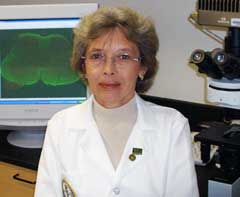|
 A Life-Line for a Lifetime A Life-Line for a Lifetime
Umbilical cords are routinely thrown away every day. Most parents don't realize that the blood left in the umbilical cord contains stem cells that have been used successfully to treat more than 45 different medical disorders. Gradually more Canadian parents are choosing to store their baby's cord blood stem cells.
Baby's blood is precious to mom:
In 2001 Patrizia Durante was pregnant when a routine prenatal test showed that she had two different forms of leukemia. She delivered her baby prematurely and she had the foresight to ask that the cord blood be stored. Patrizia then endured 213 blood transfusions, 9 bone marrow biopsies and long bouts of chemotherapy. After a two-month remission, her leukemia was back. Doctors searched for a matching bone marrow donor but none could be found. When doctors told her she would die, Patrizia reminded them that they could use the cord blood. A five - minute transfusion of the cord blood was all it took. Within two months, her blood showed signs of improvement. Patrizia is now cured and her three-year old daughter is a happy, healthy girl.
How cord blood is stored:
The process is very simple. Parents register with a cord blood company and are provided with a collection kit that they take to the delivery room. After the baby is born and the umbilical cord is cut, a health professional collects the cord blood in the kit. Obstetrician, Dr. Michael Virro states, "The procedure takes less than 5 minutes and there is no risk to mother or baby." The kit is shipped back to the laboratory where the stem cells are isolated and removed from the rest of the blood cells. They are then frozen and stored. Parents pay for processing the blood and will pay approximately $115 per year to have it stored. Some companies can accept new patients just days prior to delivery however most parents obtain their collection kits at about 36 weeks in case early labour begins.
Uses:
The first cord blood transplant occurred in the late 1980's and since that time, its use has expanded exponentially around the globe. The US government has dedicated millions of dollars to umbilical cord stem cell research as an alternative to using controversial embryonic stem cells. Results are promising in the treatment of heart disease, stroke, diabetes, multiple sclerosis, Alzheimers, Parkinsons, and ALS.
Originally used to treat childhood leukemias, these remarkable cells are now being used to successfully treat over 45 different diseases. New England Journal of Medicine has reported successful use of cord blood in the treatment of adult leukemia as well as Krabbe's disease in children. Cancer patients whose immune systems have been compromised after radiation and chemotherapy benefit enormously when these stem cells help them rebuild healthy bone marrow. Patrizia's story of being unable to find a matching bone marrow donor is common-place because bone marrow recipients will reject any transplant that is not an identical match. Remarkably, a 50% match can be adequate for cord blood transplantation, making its potential for use with family members and unrelated recipients enormous. This is particularly important for children of mixed ethnic parentage, where finding a perfect bone marrow match is extremely difficult, if not impossible.
What to look for in a cord blood company:
When the time comes to use the cord blood, all transplant facilities, cancer treatment centres and physicians will review the cord blood processing company carefully to ensure that the cord blood is safe to transfuse into a sick patient. Canada has recently established criteria for accreditation of cord blood facilities but, to date, no private companies have been evaluated. It is possible that cord blood samples will be stored for many years before they are used so it is imperative that your cord blood bank is financially stable, scientifically advanced, and ethically sound. All parents should ask the following questions when reviewing a cord blood bank:
1. When did the company open?
2. How many samples has it processed and stored at the current facility?
3. Has a sample been used for medical treatment from the facility?
4. Does the company have an accreditation certificate from an accreditation body?
5. Is your company financially stable so that my cord blood sample will be available if required 20 years from now?
6. Is your processing and storage system a closed system (preferable as it prevents contamination from other samples) or an open system (samples may be open to environmental influences in the lab and storage container)
Ethics and Religion:
Unlike the debate surrounding the use of embryonic stem cells, there are no ethical issues associated with the collection/ use of cord blood stem cells. These stem cells come from tissues that would normally be tossed in the waste after childbirth. Dr. Peter Hollands notes, "The collection and storage procedure is easy, safe, quick, and low-cost. There is no discomfort to mother or child. There's really no downside ... except that many people still don't know about it."
Our Adverts: Ukrainian wives differs in attitude to marriage from all the other ladies, it is why they are best mothers and wives.
|
|